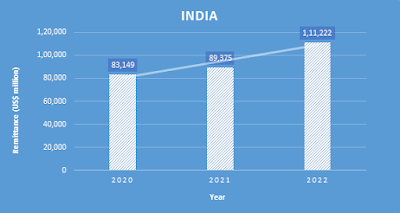According to the most recent publication from The World Bank's press release dated June 13, 2023, Indians have received $111.22 Billion as remittances in the financial year 2021-22. This is a big deal because it's the first time any country has ever received such a large amount of money in remittances. In 2022, India achieved a notable milestone by surpassing the threshold, displaying a remarkable year-on-year expansion of 12%. It's probable that in the financial year 2022-23, India will likely maintain its position as the leading recipient of remittances, a title it had taken over from China in the financial year 2020-21.
The latest information shows that the consistent and rapid increase in "personal transfers" to India, which was disrupted during the financial year 2020-2021 due to the pandemic, not only started again but also got stronger. The significant rise in remittances is happening at a time when the flow of Foreign Direct Investment (FDI) between different countries seems to be slowing down.
The reason for this increase is that wages (the money people earn for their work) have gone up, and there are many good job opportunities in the United States and other developed countries. So, Indians working in these places are sending more money back to their families in India.
According to a group that provides financial support for development across multiple countries, around $630 billion was sent as remittances to nations with lower to middle levels of income in the year 2022. This amount increased by 5% compared to the previous year. These remittances sent to these countries were almost equal to the money they received as foreign direct investment (FDI) during the same year.
Foreign Direct Investment (FDI) coming into India dropped by 15% compared to the previous year, reaching a total of $36.75 billion during the months from April to December in the current financial year. This data is according to the department responsible for promoting industry and trade within the country.
India is receiving money as remittances from countries like Qatar, Saudi Arabia, Australia, and the United States, leading to an inflow of funds. It's worth noting that approximately 18 million Indians are living outside their home country, making it the largest diaspora globally. This huge diaspora signifies the impact, demand and reliability of Indians
In regions like the Gulf, where many Indians have migrated, the distribution of vaccines and the reopening of travel have allowed migrant workers to return to their jobs. Additionally, the benefits of higher oil prices have contributed to overseas workers sending more money back to their families, as reported by Bloomberg.
Money sent by individuals to India from other countries is a big help for the country's economy, even though India often spends more on importing goods than it earns from exporting them. Lately, India is making more money from services it provides to other countries, which has helped the country manage its finances better.
The Trade Deficit is being reduced continuously, leading to a decrease in the country's overall financial gap. This happened in the third quarter of the financial year 2022-2023. In the following quarter, the difference in trade also reduced, and experts predict that for the entire financial year, the financial gap will be around $77-80 billion, which is not too concerning.
GOOD TO KNOW:






0 Comments